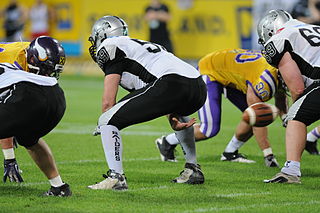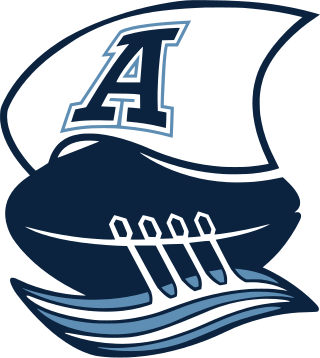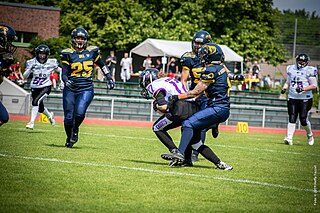
Canadian football, or simply football, is a sport in Canada in which two teams of 12 players each compete on a field 110 yards (101 m) long and 65 yards (59 m) wide, attempting to advance a pointed oval-shaped ball into the opposing team's end zone.

A snap is the backward passing of the ball in gridiron football at the start of play from scrimmage.

The Toronto Argonauts are a professional Canadian football team competing in the East Division of the Canadian Football League (CFL), based in Toronto, Ontario. Founded in 1873, the team is the oldest existing professional sports team in North America still using its original name, as well as the oldest-surviving team in both the modern-day CFL and East Division. The team's origins date back to a modified version of rugby football that emerged in North America in the latter half of the 19th century. The Argonauts played their home games at Rogers Centre from 1989 until 2016, when the team moved to BMO Field, the fifth stadium site to host the team.

Gridiron football, also known as North American football, or in North America as simply football, is a family of football team sports primarily played in the United States and Canada. American football, which uses 11 players, is the form played in the United States and the best known form of gridiron football worldwide, while Canadian football, which uses 12 players, predominates in Canada. Other derivative varieties include arena football, flag football and amateur games such as touch and street football. Football is played at professional, collegiate, high school, semi-professional, and amateur levels.

A down is a period in which a play transpires in gridiron football. The down is a distinguishing characteristic of the game compared to other codes of football but is synonymous with the 6 "tackle" rule in rugby league. The team in possession of the football has a limited number of downs to advance ten yards or more towards their opponent's goal line. If they fail to advance that far, possession of the ball is turned over to the other team. In most situations if a team reaches their final down, they will punt to their opponent, which forces their opponent to begin their drive from further down the field; if they are in range, they might instead attempt to score a field goal.

American and Canadian football are gridiron codes of football that are very similar; both have their origins partly in rugby football, but some key differences exist between the two codes.

Football Canada is the governing body for gridiron football in Canada headquartered in Ottawa, Ontario. Football Canada focuses primarily its own Canadian form of the sport, and is currently the world's only national governing body for Canadian football.
The West Division is one of the two regional divisions of the Canadian Football League (CFL), its counterpart being the East Division.
The East Division is one of the two regional divisions of the Canadian Football League, its counterpart being the West Division. Although the CFL was not founded until 1958, the East Division and its clubs are descended from earlier leagues.
The Ontario Rugby Football Union (ORFU) was an early amateur Canadian football league comprising teams in the Canadian province of Ontario. The ORFU was founded on Saturday, January 6, 1883 and in 1903 became the first major competition to adopt the Burnside rules, from which the modern Canadian football code would evolve.

A comparison of American football and rugby union is possible because of the games' shared origins, despite their dissimilarities.
The 42nd Grey Cup football game was played on November 27, 1954, before a full house at Varsity Stadium in Toronto, Ontario, Canada.
After a four year absence due to the First World War, the Grey Cup was up for grabs once again as a couple of familiar foes battled for the trophy. The Toronto Varsity Blues defeated the Toronto Argonauts. It was the final time these cross-town rivals challenged each other for the Grey Cup.
The 1905 Canadian football season was the 14th season of organized play since the Canadian Rugby Union (CRU) was founded in 1892 and the 23rd season since the creation of the Ontario Rugby Football Union (ORFU) and the Quebec Rugby Football Union (QRFU) in 1883. The season concluded with the Toronto University team defeating the Ottawa Rough Riders in the 1905 Dominion Championship game.
The Intercollegiate Football Association (IFA), also known as the American Intercollegiate Football Association, was one of the earliest college football rules-making and scheduling organizations in existence; it was active from the 1873 to 1893 seasons. The IFA teams, Columbia, Harvard, Princeton, and Yale, are now members of the Ivy League.
The 1905 Dominion Championship was a Canadian football game that was played on November 25, 1905 at Rosedale Field in Toronto, Ontario that determined the Senior Rugby Football champion of Canada for the 1905 season. The Canadian Intercollegiate Rugby Football Union (CIRFU) champion Toronto University team defeated the Quebec Rugby Football Union (QRFU) champion Ottawa Rough Riders in an 11–9 comeback victory to win their second Dominion Championship. This was the third appearance in the title game for Varsity and the fourth appearance for the Rough Riders while also being their first loss in the championship game.
The 1902 Dominion Championship was a Canadian football game that was played on November 15, 1902 at the Ottawa College Grounds in Ottawa, Ontario that determined the Senior Rugby Football champion of Canada for the 1902 season. The Ontario Rugby Football Union (ORFU) champion Ottawa Rough Riders defeated the Quebec Rugby Football Union (QRFU) champion, and defending national champion, Ottawa College in a 5–0 victory to win their third Dominion Championship. This was a re-match of the 1898 Dominion Championship game which the Rough Riders also won on the Ottawa College Grounds. The Rough Riders made their third appearance in the title game, all within five years, and it was the seventh appearance for Ottawa College with their only losses in the game coming from the Rough Riders.
The 1884 Rugby Football Championship of the Dominion was a Canadian football game that determined the Senior Rugby Football champion of Canada for the 1884 season. The game was played on Thanksgiving Day on November 6, 1884 on the University lawn at the University of Toronto in Toronto, Ontario. The Quebec Rugby Football Union (QRFU) champion Montreal Football Club defeated the Ontario Rugby Football Union (ORFU) champion Toronto Football Club with a 30–0 victory in the first ever game to decide a national champion, as directed by the Canadian Rugby Football Union.








